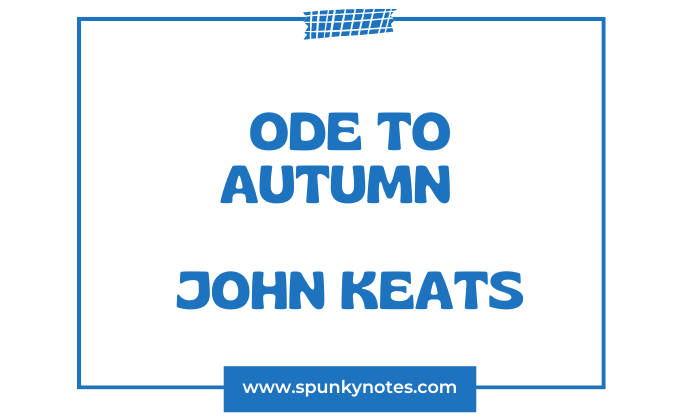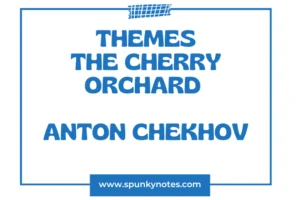
Q. Critically analyze the Ode to Autumn by John Keats.
An ode is a type of lyrical poem, typically of a serious or meditative nature and having a formal structure. It is often addressed to a particular subject, exploring its various facets and emotions.
Odes originated in ancient Greece, and various poets have adopted and adapted the form throughout history.
Ode to Autumn by John Keats Analysis
Stanza 1
Season of mists and mellow fruitfulness,
Close bosom-friend of the maturing sun;
Conspiring with him how to load and bless
With fruit, the vines that round the thatch-eves run;
To bend with apples, the moss’d cottage-trees,
And fill all fruit with ripeness to the core;
To swell the gourd, and plump the hazel shells
With a sweet kernel, to set budding more,
And still more, later flowers for the bees,
Until they think warm days will never cease,
For summer has o’er-brimm’d their clammy cells.
Season of mists and mellow fruitfulness
This line introduces Autumn as a period characterized by foggy, misty mornings and a time of abundant harvest. The term “mists” brings to mind the calm, damp atmosphere of autumn mornings, while “mellow fruitfulness” emphasizes the ripeness and abundance of the season’s fruits and crops.
The word “mellow” here conveys a sense of gentle richness and maturity, perfectly capturing the generous nature of the harvest season.
Close bosom-friend of the maturing sun,
Keats personifies autumn as having a close relationship with the sun, described as “maturing.” This metaphor suggests the vital role of the sun in the ripening process of fruits during the autumn season.
The phrase “close bosom-friend” implies a deep, intimate connection, illustrating the harmonious interplay between the season and the sun in nurturing the natural world.
The phrase “of the maturing sun” means the sun is like it’s getting older and changing from the strong heat of summer to the softer warmth of autumn. This softer sun helps make the crops ready to be picked. It shows the sun’s role in making sure fruits and crops are perfect for harvest in autumn.
Conspiring with him how to load and bless
In this line, Keats creatively uses the term “conspiring,” often associated with secret plans, to depict the sun’s and autumn’s collaborative efforts.
This portrayal suggests that they work together to bring about a plentiful harvest. The phrase “loading and blessing” conveys the idea of physically filling the vines with fruits and endowing the land with richness and abundance.
With fruit the vines that round the thatch-eves run;
This line presents a vivid image of vines heavy with fruit, weaving around the thatched roofs of cottages. It beautifully captures the plentiful nature of the season and its integration with human life.
Thatch-eves” refers to the edges or eaves of a roof that is covered with thatch, which is a type of roofing material made from dried vegetation like straw, reeds, or palm branches.
Thatch is commonly used in rural or traditional building styles. The “eves” (more correctly spelled “eaves”) are the lower borders of the roof that overhang the walls of the building.
When the line mentions “vines that round the thatch-eves run,” it means vines are growing up and around these thatched roof edges.
To bend with apples the moss’d cottage-trees,
“Moss’d” means covered with moss. Moss is a small, green plant that grows in moist, shady areas, often seen on trees, rocks, and the ground in forests or gardens.
When the line mentions “moss’d cottage-trees,” it describes trees near a cottage that have moss growing on them, indicating they are old and have been part of the landscape for a long time. It adds to the image of a lush, fertile, and well-established setting.
And fill all fruit with ripeness to the core;
Here, the poet expresses the completeness of the ripening process, where the fruits are ripe on the surface but through to their very core.
This line underscores the depth and thoroughness of autumn’s maturing influence on the fruits, implying perfection and fulfillment in the ripening process.
To swell the gourd, and plump the hazel shells With a sweet kernel;
These phrases describe the growth and ripening of other autumnal produce. “To Swell the Gourd” portrays how gourds (like pumpkins and squashes) increase in size, becoming whole and ripe.
“Plump the hazel shells with a sweet kernel” refers to the development of hazel nuts, which become plump with a sweet, edible seed. These lines further emphasize the richness and bounty of the season’s harvest.
To set budding more,
And still more, later flowers for the bees,
Keats notes that even as Autumn progresses, there are still flowers blooming, providing sustenance for bees. This line suggests a continuous cycle of life and growth, where new life (in the form of flowers) emerges towards the end of the growing season.
This highlights not only the abundance of Autumn but also the interconnectedness of all living things in nature.
Until they think warm days will never cease,
For summer has o’er-brimm’d their clammy cells.
In these closing lines of the stanza, Keats personifies the bees as believing that the warm days of summer will continue indefinitely because the summer has been so rich and generous that it has overflowed into autumn, filling their hives (“clammy cells”) to the brim.
The word “clammy” refers to the sticky nature of the inside of the bees’ hive cells, where they store honey. The phrase captures the abundance of the season and the bees’ continuous work during this fruitful time.
Stanza 2
Who hath not seen thee oft amid thy store?
Sometimes, whoever seeks abroad may find
Thee sitting careless on a granary floor,
Thy hair soft-lifted by the winnowing wind;
Or, on a half-reap’d furrow sound asleep,
Drowsed with the fume of poppies, while thy hook
Spares the next swath and all its twined flowers:
And sometimes like a gleaner thou dost keep
Steady thy laden head across a brook;
Or by a cider-press, with patient look,
Thou watches the last oozings, hour by hour.
Who hath not seen thee oft amid thy store?
In this line, Keats rhetorically asks who has not seen the personification of Autumn surrounded by the abundance of the harvest. It suggests that the presence of abundance, such as harvested crops or fruits, is a common and noticeable feature of the season.
It implies that the wealth and bounty of autumn are so widespread and evident that they are hard to miss. “Thy store” refers to the accumulated wealth of the harvest season, suggesting that the presence of autumn is ubiquitous and prominently visible amidst the bounty it brings.
Sometimes, whoever seeks abroad may find
Thee sitting careless on a granary floor,
Autumn is depicted as a human figure casually sitting on a granary floor, surrounded by stored grains. The word “careless” implies a relaxed, content posture.
It reflects the satisfaction and abundance of the harvest season. The granary, where harvested grains are stored, symbolizes the culmination of the agricultural year’s efforts.
Thy hair soft-lifted by the winnowing wind;
This line continues the personification, describing Autumn’s hair being gently lifted by the wind created during the winnowing process, where grains are separated from the chaff.
It evokes a serene and idyllic image, emphasizing the connection between autumn and harvest activities.
Or on a half-reap’d furrow sound asleep,
Drowsed with the fume of poppies,
while thy hook
Spares the next swath and all its twined flowers:
This imagery describes a scene of rest amidst the harvest. It paints a picture of someone falling asleep on a partially harvested furrow, the land that has been plowed but not fully reaped.
This person is lulled into sleep by the sedative effect of poppy fumes, a flower known for its narcotic properties. It suggests a deep, almost intoxicating sense of peace and relaxation amid the labor of the harvest.
‘While thy hook Spares the next swath and all its twined flowers’ indicates that the harvesting tool, likely a sickle or a scythe, is at rest as well, leaving the next section of crops and intertwined flowers untouched for the moment.
This pause in work highlights a moment of harmony between the labor of harvesting and the natural beauty of the field. It suggests a respectful coexistence with nature.
And sometimes like a gleaner thou dost keep
Steady thy laden head across a brook;
Gleaners are those who collect leftover grains from fields after the harvest. The phrase “steady thy laden head” suggests carrying a heavy load, in this case, of grain, with careful balance and control.
Crossing a brook with such a burden requires concentration and skill to avoid losing any of the precious harvest. A “brook” is a small, natural stream of water.
It’s usually narrower and shallower than a river and can be found flowing through rural areas, forests, or between hills.
Or by a cider-press, with patient look,
Thou watchest the last oozings, hours by hours.
This line describes someone standing by a cider press, watching the slow process of juice being squeezed from apples with a patient and attentive demeanor.
The “last oozings” refer to the final trickles of apple juice coming out of the press as the fruit is compressed.
Watching “hours by hours” emphasizes the slow, deliberate nature of the process and the person’s willingness to wait and observe the transformation of apples into cider.
Stanza 3
Where are the songs of Spring? Ay, where are they?
Think not of them, thou hast thy music too,—
While barred clouds bloom the soft-dying day,
And touch the stubble plains with rosy hue;
Then, in a wailful choir, the small gnats mourn
Among the river sallows, borne aloft
Or sinking as the light wind lives or dies;
And full-grown lambs loud bleat from hilly bourn;
Hedge crickets sing, and now with treble soft
The redbreast whistles from a garden-croft,
And, gathering swallows twitter in the skies.
Where are the songs of Spring? Ay, where are they?
Think not of them, thou hast thy music too—
Keats opens this stanza with a rhetorical question about the songs of Spring, suggesting their absence in Autumn. However, he quickly shifts the focus, advising Autumn (personified) not to dwell on Spring’s melodies because it has distinct music.
This “music” of autumn could refer to the sounds of harvest, the rustling of leaves, the gentle wind, or the activities associated with the season.
The lines emphasize the idea that every season has its own distinct beauty and value, and they encourage an appreciation of the present moment and the unique qualities it offers.
While barred clouds bloom the soft-dying day,
And touch the stubble-plains with rosy hue;
The phrase “barred clouds” refers to clouds streaked across the sky, creating a pattern reminiscent of bars. These clouds contribute to the ‘blooming’ or gradual fading of daylight, a typical sight in autumn evenings.
The “soft-dying day” poetically describes the setting sun, and “stubble-plains” are fields after harvest, now only showing stubble, which the sun tints with a rose-like color.
Then in a wailful choir the small gnats mourn
Among the river sallows, borne aloft
Or sinking as the light wind lives or dies;
These lines describe a scene in which small gnats are buzzing or whining in a group that sounds like a sad chorus. They do this among the willow trees (“sallows”) by the river.
If the breeze blows, the gnats fly up; if it stops, they fall. The imagery captures the delicate dance of the gnats, influenced by the gentle movements of the wind. It creates a scene of natural beauty and melancholy.
And full-grown lambs loud bleat from hilly bourn;
This line describes the sound of mature lambs bleating in a hilly area. The word “bourn” here means a small stream or a boundary in the countryside, indicating a rural setting.
The bleating of the lambs adds to the symphony of sounds unique to autumn.
Hedge-crickets sing, and now with treble soft
The redbreast whistles from a garden-croft,
Keats mentions “hedge-crickets” (crickets that live among hedges) chirping, a typical sound as evening approaches in autumn.
A “redbreast,” or robin, adds to this melody with its soft, high-pitched (“treble”) whistle. The robin is in a “garden-croft,” a small, enclosed field or garden near a house, typical in rural landscapes.
And gathering swallows Twitter in the skies.
The stanza concludes with the image of swallows. They gather and chirp (Twitter) in the sky, a behavior typical as they prepare for migration. Their twittering adds to the sounds of autumn, joining the natural “music” of the season.

